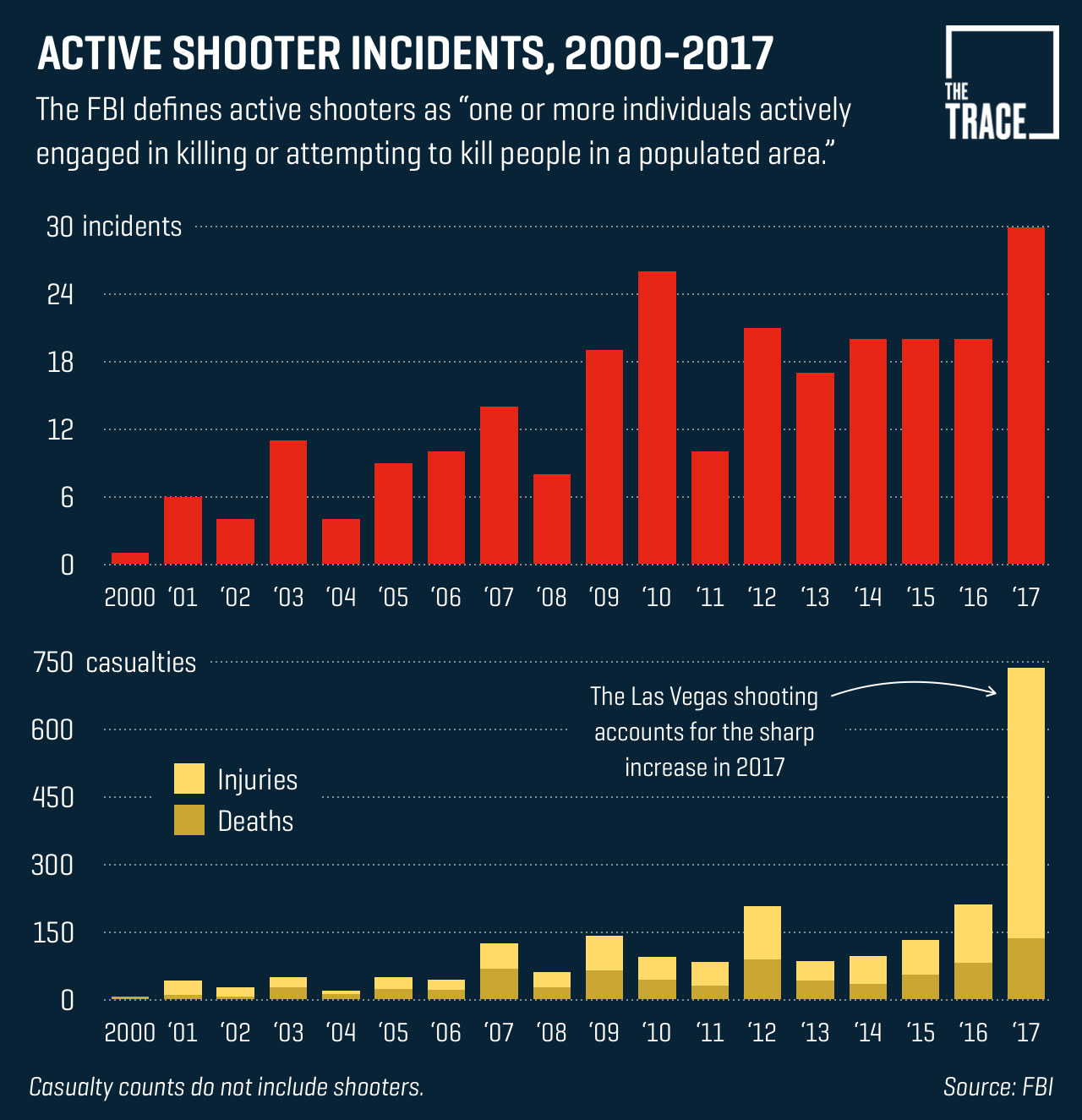More Americans were killed or wounded by active shooters in 2017 than in any year since the Federal Bureau of Investigation began keeping track.
All told, nearly 750 people were shot in 30 incidents, according to a newly released FBI report. The shooters were of different ages, from different places, and motivated by different grievances. But all were men, and all acted alone.
Casualties jumped dramatically from 2016 to 2017, though the entirety of that increase can be attributed to the Las Vegas strip massacre, which alone had more than 500 victims. Even subtracting the toll of that one event, 2017 was among the deadliest years on record.
Between 2010 and 2016, an average of 127 Americans were shot in active shootings each year, setting the United States apart from the rest of the world.
“The U.S. is off the charts,” said Frederic Lemieux, a criminologist with Georgetown University who has been researching mass shootings from a global perspective since 2012. “In sheer number, nothing reaches what the U.S. has in victims and number of incidents.”

The FBI defines active shooters as “one or more individuals actively engaged in killing or attempting to kill people in a populated area.” This definition encompasses shootings that happen in schools, workplaces, and other public spaces. A shooting can be categorized as an active shooter incident even if no one is killed or wounded.
Accidental shootings, suicides, and drug- and gang-related gun violence are excluded from the FBI’s methodology, which was developed with researchers from Texas State University’s Advanced Law Enforcement Rapid Response Training (ALERRT) Center. The center partnered with the FBI to produce the report, using data collected from police department reports, FBI resources, and media articles. Some active shooting incidents may have gone unrecorded in the early 2000s, researchers said, but they captured most of them.
M. Hunter Martaindale, director of research at the ALERRT Center, said it isn’t clear yet whether the recent surge in incidents and deaths means active shootings will continue to go up.
“If it stays this way, it goes from anomaly to more of a trend,” he said. Prior to last year, he noted, the number of yearly incidents appeared to be leveling off after increasing steadily since the start of the 2000s.
The FBI’s first active shooter study started out as Martaindale’s master thesis. After the Sandy Hook shooting in 2012, the FBI teamed up with Texas State University to begin tracking and analyzing active shooter events.
The relative rarity of active-shooter incidents makes analyzing trends in the data difficult, Martaindale said. But certain patterns are clear: 96 percent of the shooters since 2000 were male, and nearly two-thirds of all incidents happened in businesses and schools.
Active shooter incidents by location
| Location | Incident count | Percent of incidents |
|---|---|---|
| Commerce | 105 | 42.0% |
| Education | 52 | 20.8% |
| Open space | 35 | 13.0% |
| Government | 25 | 10.0% |
| Residence | 12 | 4.8% |
| House of worship | 10 | 4.0% |
| Healthcare | 10 | 4.0% |
| Other | 1 | 0.4% |
Source: FBI
Of the 27 documented school shootings that were carried out by minors (younger than age 18), more than half were halted by unarmed teachers, students, or other school staff. In several cases, school authorities ended the violence by merely ordering the shooters to put down their guns. One school shooting was prevented by an armed adult who wasn’t a police officer.
More than half of active shootings were resolved in some way before police arrived on the scene. Of these, a quarter of the shooters killed themselves. Another 12 percent fled the scene. Four percent of shooters were stopped by armed citizens, including security guards. Twelve percent were stopped by unarmed citizens.
“What a civilian does has a very large impact on how these events unfold and how they end,” said Martaindale. “When the civilians get involved and fight back, they can end pretty quick.”
However, the FBI and ALERRT say that people in an active shooting situation should run away if possible, find a safe place to hide and barricade themselves if escaping the scene isn’t an option, and confront the shooter as a last resort.
In nearly 15 percent of the incidents tracked by researchers, police officers were either wounded or killed.
“It’s the most dangerous call a law enforcement officer can go on,” Martaindale said.

